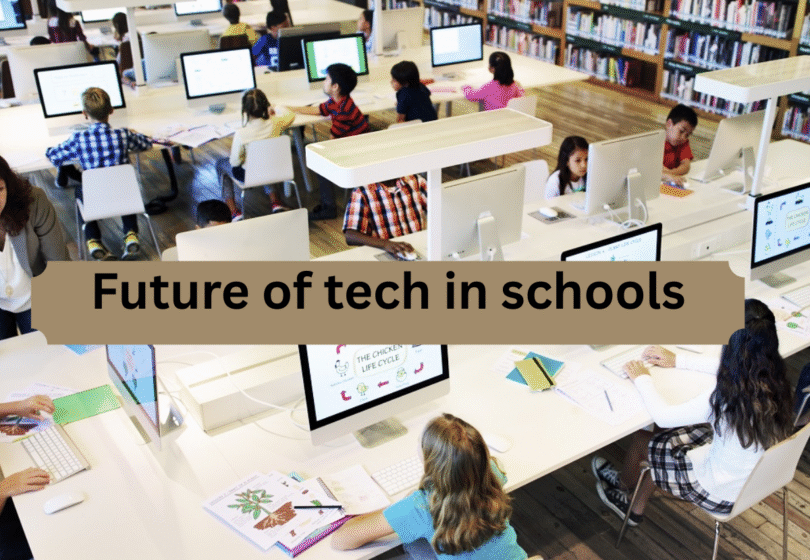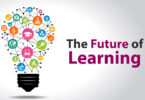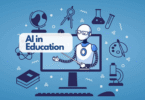Close your eyes and imagine a classroom where students wear VR headsets to explore Mars, AI tutors assist them in real-time, and teachers focus more on mentoring than lecturing. That’s not a sci-fi movie—it’s the future of tech in schools, and it’s closer than you think.
Technology is reshaping education. From smart classrooms to AI-driven personalized learning, schools are undergoing a massive digital transformation. But what exactly does the future hold? Let’s dive into a friendly conversation about the upcoming trends, their benefits, and the challenges schools will face.
How Technology is Currently Used in Schools

Right now, many schools have already adopted:
- Smartboards and interactive displays
- Online learning platforms like Google Classroom & Microsoft Teams
- Laptops and tablets for digital note-taking
- Educational apps and eBooks
- Virtual classes (especially after COVID-19)
But this is just scratching the surface. The future of tech in schools is far more dynamic, interactive, and personalized.
Future Technologies That Will Transform Schools
1. Virtual Reality (VR) & Augmented Reality (AR)
- What it is: VR creates a fully immersive virtual environment, while AR overlays digital information onto the real world.
- In Schools: Students can virtually visit the Great Wall of China or conduct risky science experiments in a safe VR lab.
- Impact: Learning becomes more visual and engaging, helping students understand complex topics with ease.
2. Artificial Intelligence (AI) in Classrooms
- What it is: AI algorithms that analyze student performance and customize learning materials.
- In Schools: AI tutors will assist students with subjects they struggle in, offering personalized quizzes and instant feedback.
- Impact: Adaptive learning paths ensure no student is left behind, catering to individual strengths and weaknesses.
3. Gamification of Learning
- What it is: Turning lessons into interactive games with rewards and challenges.
- In Schools: Math quizzes become fun battles, history lessons transform into interactive story missions.
- Impact: Increased motivation, better retention of information, and improved student participation.
4. Cloud-Based Learning Ecosystems
- What it is: A digital space where students can access lessons, homework, and resources from anywhere.
- In Schools: Cloud platforms will host all teaching materials, collaborative projects, and even AI-driven analytics on student progress.
- Impact: Flexibility in learning, easier collaboration, and reduced paper usage.
5. Internet of Things (IoT) in Smart Classrooms
- What it is: Network of interconnected smart devices in classrooms.
- In Schools: Smart desks that monitor posture, automated attendance systems, and environment controls that adjust lighting and temperature for comfort.
- Impact: Enhanced learning environment and operational efficiency.
6. 5G & High-Speed Connectivity
- What it is: Ultra-fast internet with minimal lag.
- In Schools: Real-time global classrooms, high-definition virtual tours, and seamless remote learning.
- Impact: High-quality, uninterrupted learning experiences regardless of location.
Detailed Benefits of Future Tech in Schools

- Personalized Learning for Every Student
- AI adapts content to individual learning styles and paces.
- Slow learners get extra support while advanced learners are given challenging tasks.
- AI adapts content to individual learning styles and paces.
- Increased Engagement through Interactive Tools
- VR, AR, and gamified lessons make learning enjoyable.
- Visual learners benefit from rich multimedia content.
- VR, AR, and gamified lessons make learning enjoyable.
- Accessibility & Inclusion
- Students from remote or underprivileged areas can attend virtual classes.
- Tools like text-to-speech and language translation help students with disabilities or language barriers.
- Students from remote or underprivileged areas can attend virtual classes.
- Real-time Performance Tracking
- AI-driven dashboards provide instant feedback on student progress.
- Teachers can identify weak areas and tailor their teaching accordingly.
- AI-driven dashboards provide instant feedback on student progress.
- Time and Resource Efficiency
- Automation of grading and administrative tasks allows teachers to focus on creative teaching.
- Digital content reduces dependency on physical books and paper.
- Automation of grading and administrative tasks allows teachers to focus on creative teaching.
- Global Collaborative Learning
- Students can collaborate on projects with peers from different countries.
- Exposure to diverse perspectives enhances critical thinking and cultural awareness.
- Students can collaborate on projects with peers from different countries.
You may also like to read these posts:
Must-Read Educational Books: Your Ultimate Guide to Learning & Growth
Free Learning Resources Online: The Ultimate Guide to Learning Without Spending Money
Best Books for Students: A Must-Read Guide for Every Learner
Digital Libraries for Education: Unlocking Limitless Learning Opportunities
Detailed Drawbacks and Challenges of Tech in Schools
- High Cost of Implementation
- Smart classrooms, VR kits, AI platforms, and IoT devices require significant investment.
- Not all schools, especially in developing regions, can afford these technologies.
- Smart classrooms, VR kits, AI platforms, and IoT devices require significant investment.
- Digital Divide
- Students from low-income families may not have access to devices or reliable internet.
- This can widen the gap between privileged and underprivileged students.
- Students from low-income families may not have access to devices or reliable internet.
- Teacher Training and Adaptation
- Teachers need to be trained to effectively use new technologies.
- Resistance to change and lack of tech-savviness can slow down adoption.
- Teachers need to be trained to effectively use new technologies.
- Overdependence on Technology
- Too much reliance on digital tools might reduce critical thinking and problem-solving abilities.
- Students may become passive consumers of information rather than active learners.
- Too much reliance on digital tools might reduce critical thinking and problem-solving abilities.
- Increased Screen Time
- Prolonged use of digital devices can lead to health issues like eye strain, poor posture, and reduced physical activity.
- Mental health concerns such as digital fatigue and social isolation may also arise.
- Prolonged use of digital devices can lead to health issues like eye strain, poor posture, and reduced physical activity.
- Data Privacy and Cybersecurity Threats
- Student data is sensitive and valuable. Schools must invest in robust cybersecurity measures.
- Risks of data breaches, hacking, and misuse of personal information are real challenges.
- Student data is sensitive and valuable. Schools must invest in robust cybersecurity measures.
The Teacher’s Role in Tech-Driven Schools
While technology will automate many tasks, teachers will play an even more critical role as:
- Facilitators of Learning
- Mentors and Emotional Support Providers
- Curators of Educational Content
- Guides for Ethical Use of Technology
The human connection in teaching will always remain irreplaceable.
Conclusion
The future of tech in schools is promising and exciting. It will make learning more inclusive, engaging, and personalized. However, it’s essential to address the challenges of accessibility, overdependence, and cybersecurity. By adopting a balanced approach where technology complements, not replaces, traditional teaching methods, we can ensure a brighter, smarter future for education.https://parco.gov.ba/
FAQs
1. How will technology change schools in the next 10 years?
2. Will technology replace teachers in the future?
3. What is the role of Virtual Reality (VR) in education?
4. What are the benefits of using AI in schools?
Personalize lessons based on each student’s pace.
Provide instant feedback and assessments.
Help teachers identify students’ weak areas.
Automate grading and administrative tasks, saving teachers valuable time.







